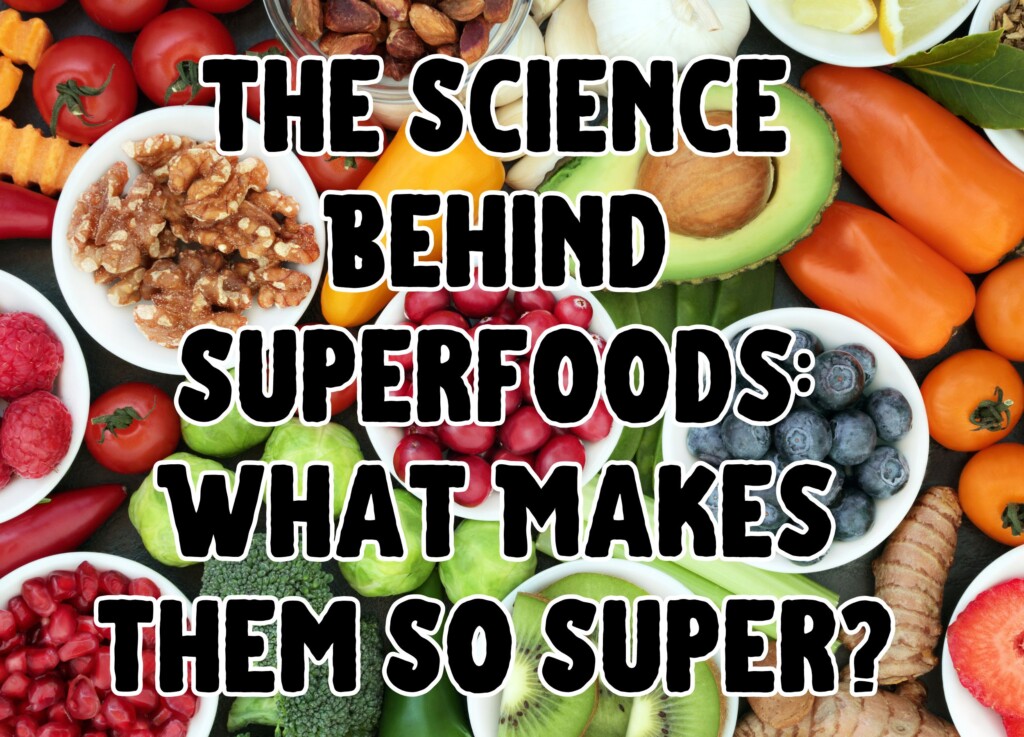In recent years, the term “superfoods” has become a buzzword in the health and wellness community. These nutrient-dense foods are touted for their exceptional health benefits, from boosting immunity to fighting off chronic diseases. But what exactly makes these foods “super”? Let’s delve into the nutritional science behind superfoods and uncover what sets them apart from your average fruits and veggies.

Nutrient Density: The Core of Superfoods
The primary factor that elevates a food to “super” status is its nutrient density. Nutrient-dense foods are rich in vitamins, minerals, antioxidants, and other beneficial compounds while being relatively low in calories. This means you get a bigger bang for your nutritional buck. For those interested in diving deeper into the world of nutrient-dense foods, the eBook “Unlock the Secrets to a Longer, Healthier Life with Superfoods” offers a comprehensive guide.
Antioxidant Powerhouse
One of the standout features of superfoods is their high antioxidant content. Antioxidants are compounds that neutralize free radicals, unstable molecules that can damage cells and contribute to aging and diseases like cancer. Foods like berries, dark chocolate, and nuts are rich in antioxidants and are often featured in lists of superfoods.
Anti-Inflammatory Properties
Inflammation is a natural response to injury or infection, but chronic inflammation can lead to various health issues, including heart disease and diabetes. Many superfoods, such as turmeric and fatty fish, have potent anti-inflammatory properties. If you’re looking to combat inflammation through your diet, the eBook “Unlock the Secrets to a Longer, Healthier Life with Superfoods” can be an invaluable resource.
Rich in Fiber and Healthy Fats
Fiber is essential for a healthy digestive system, and foods like chia seeds and legumes are excellent sources. Healthy fats, particularly omega-3 fatty acids found in foods like salmon and flaxseeds, are crucial for brain health and reducing inflammation.
Versatility and Accessibility
Superfoods aren’t just exotic fruits from far-off lands; many are readily available and can be easily incorporated into your daily diet. From blueberries to quinoa, these foods are as versatile as they are nutritious. For a detailed guide on how to integrate these foods into your meals, check out “Unlock the Secrets to a Longer, Healthier Life with Superfoods”.
Superfoods offer a plethora of health benefits, thanks to their high nutrient density and medicinal properties. Incorporating these foods into your diet can be a game-changer for your health and well-being. If you’re looking to take a deep dive into the world of superfoods, the eBook “Unlock the Secrets to a Longer, Healthier Life with Superfoods” provides a comprehensive look into what makes these foods so exceptional and how you can benefit from them.
In recent years, the term “superfoods” has become a buzzword in the health and wellness community. These nutrient-dense foods are touted for their exceptional health benefits, from boosting immunity to fighting off chronic diseases. But what exactly makes these foods “super”? Let’s delve into the nutritional science behind superfoods and uncover what sets them apart from your average fruits and veggies.
Nutrient Density: The Core of Superfoods
The primary factor that elevates a food to “super” status is its nutrient density. Nutrient-dense foods are rich in vitamins, minerals, antioxidants, and other beneficial compounds while being relatively low in calories. This means you get a bigger bang for your nutritional buck. For those interested in diving deeper into the world of nutrient-dense foods, the eBook “Unlock the Secrets to a Longer, Healthier Life with Superfoods” offers a comprehensive guide.
Antioxidant Powerhouse
One of the standout features of superfoods is their high antioxidant content. Antioxidants are compounds that neutralize free radicals, unstable molecules that can damage cells and contribute to aging and diseases like cancer. Foods like berries, dark chocolate, and nuts are rich in antioxidants and are often featured in lists of superfoods.
Anti-Inflammatory Properties
Inflammation is a natural response to injury or infection, but chronic inflammation can lead to various health issues, including heart disease and diabetes. Many superfoods, such as turmeric and fatty fish, have potent anti-inflammatory properties. If you’re looking to combat inflammation through your diet, the eBook “Unlock the Secrets to a Longer, Healthier Life with Superfoods” can be an invaluable resource.
Rich in Fiber and Healthy Fats
Fiber is essential for a healthy digestive system, and foods like chia seeds and legumes are excellent sources. Healthy fats, particularly omega-3 fatty acids found in foods like salmon and flaxseeds, are crucial for brain health and reducing inflammation.
Versatility and Accessibility
Superfoods aren’t just exotic fruits from far-off lands; many are readily available and can be easily incorporated into your daily diet. From blueberries to quinoa, these foods are as versatile as they are nutritious. For a detailed guide on how to integrate these foods into your meals, check out “Unlock the Secrets to a Longer, Healthier Life with Superfoods”.
Superfoods offer a plethora of health benefits, thanks to their high nutrient density and medicinal properties. Incorporating these foods into your diet can be a game-changer for your health and well-being. If you’re looking to take a deep dive into the world of superfoods, the eBook “Unlock the Secrets to a Longer, Healthier Life with Superfoods” provides a comprehensive look into what makes these foods so exceptional and how you can benefit from them.
As an Amazon Associate we earn from qualifying purchases through some links in our articles.




